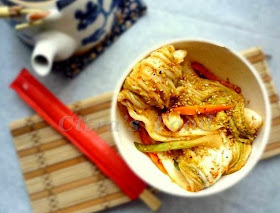The earliest references to pickled vegetables in East Asia are found in the Chinese Xin Nan Shan 信南山 poem of theShi Jing (詩經), which uses the character 菹 or 葅 (Korean "jeo", modern Mandarin Chinese "ju1"). The term ji was used until the pre-modern terms chimchae (hanja: 沉菜, lit. soaked vegetables), dimchae, and timchae were adopted in the period of the Three Kingdoms of Korea The word then was modified into jimchi, and is currently kimchi.
Early kimchi was made of cabbage and beef stock only. Red chili, a New World vegetable not found in Korea beforeEuropean contact with the Americas, was introduced to Korea from Japan after the Japanese invasions (1592–1598) and became a staple ingredient in kimchi, although its use was not documented until the 18th century. Red chili pepper flakes are now used as the main ingredient for spice and source of heat for many varieties of kimchi. In the twelfth century other spices, creating flavors such as sweet and sour, and colors, such as white and orange, were added.
Kimchi is Korea's national dish. During South Korea's involvement in the Vietnam War its government requested American help to ensure that South Korean troops, reportedly "desperate" for the food, could obtain it in the field; South Korean president Park Chung-hee told U.S. President Lyndon B. Johnson that kimchi was "vitally important to the morale of Korean troops".It was also sent to space on board Soyuz TMA-12 with Yi So-Yeon after a multi-million dollar research effort to kill the bacteria and lessen the odor without affecting taste.
Source: Wikipedia
For more information about Kimchi you can visit here.
For my Kimchi post today İ copy from Maangchi.com (Cooking Korean Food) with minor adjustment.
And here my recipe:
How to:
And here my recipe:
- 2 head medium napa cabbage (around 1 kg each)
- 1/2 - 3/4 cup salt
- 2 cup water
- 2 Tbsp rice flour (original recipe calls for glutinous rice flour)
- 2 Tbsp sugar
- 2 cups radish matchsticks--> İ use red radish
- 1 cup carrot matchsticks
- 7 to 8 green onions, roughly chopped
- 1/2 cup garlic cloves (24 garlic cloves)
- 2 teaspoon minced ginger
- 1 medium onion
- 1/2 cup fish sauce
- 1/4 cup fermented salted shrimp (saeujeot) with the salty brine, chopped --> İ skipped
- 2 cups hot pepper flakes (gochugaru) --> İ use local hot pepper flakes and use 1 cup only because local pepper flake İ notice has stronger hot spice taste.
How to:
1 ) Split a cabbage in half without shredding the densely packed leaves inside, first cut a short slit in the base of the cabbage, enough to get a grip on either half, and then gently pull the halves apart so the cabbage splits open. Cut a slit through the core of each half, 2 inches above the stem. You want the cabbage leaves to be loose but still attached to the core.
Dunk the halves in a large basin of water to get them wet. Sprinkle the salt between the leaves by lifting up every leaf and getting salt in there. Use more salt closer to the stems, where the leaves are thicker.
Dunk the halves in a large basin of water to get them wet. Sprinkle the salt between the leaves by lifting up every leaf and getting salt in there. Use more salt closer to the stems, where the leaves are thicker.
2) Let those cabbage sit for 2 hour and turn over every 30 minutes to get all part salted. After 2 hours, wash then under running water to remove salt and dirt. Drain them well onto strainer.
While waiting your cabbage salted you can prepare your porridge:
1) İ pure onion, garlic and ginger with hand blender. set a side. İn small sauce pan combine rice flour and water, cook over medium heat until it's start to bubble, add sugar and stir again about 1 or 2 minute. Remove from heat and let it completely cool.
2)After porridge cool, add paste spice, fish sauce and red pepper flakes, stir to combine. Add carrot, radish, green onion and fermented salted shrimp (if you use one). Mix well to combine.
Make kimchi:
- Spread some kimchi paste on each cabbage leaf. When every leaf in a quarter is covered with paste, wrap it around itself into a small packet, and put into your jar, plastic container.
- Eat right away, or let it sit for a few days to ferment.
- The kimchi will start fermenting a day or two at room temperature, depending on the temperature and humidity of your room. The warmer and more humid it is, the faster the kimchi will ferment. Once it starts to ferment it will smell and taste sour, and pressing on the top of the kimchi with a spoon will release bubbles from beneath.

bubbles shown it fermented - Once it starts to fermented, store in the refrigerator to use as needed. This slows down the fermentation process, which will make the kimchi more and more sour as time goes on.





No comments:
Post a Comment
Enjoying my blog? Help spread the word by sharing it with your friends and letting everyone know that my content is valuable and worth visiting. Don’t forget to subscribe or follow me on Facebook, Twitter, Pinterest, or Instagram!